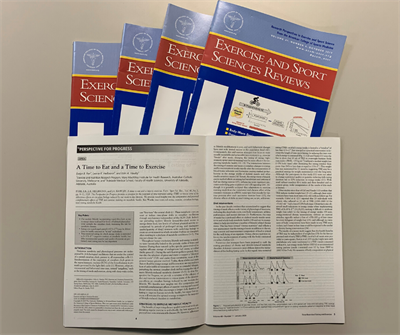Roger M. Enoka, Ph.D. |
Dec.
27, 2019

The mission of Exercise and Sport Sciences Reviews (ESSR) is to provide forward-thinking reviews on contemporary issues that are of interest to members of ACSM. The journal publishes four issues each year: available by January, April, July and October. The charge to feature forward-thinking content is accomplished by inviting authors to provide either the rationale for a novel hypothesis or to summarize work on a contemporary issue and identify the key gaps in knowledge that need to be addressed to move the field forward.
The extent to which we achieve our mission can be assessed with two metrics: one related to the number of times the content is either read (viewed) or mentioned and one that reports the relative citation count of the published articles. Our articles can be accessed and read either through an institutional subscription to the journal (Ovid) or through the ACSM website. Typically, the read count (Ovid + ACSM) is greater for articles that were published in the years preceding a current year. This year, however, an article published in 2019 (April issue) achieved the second highest read count for the year. The topic was exercise and the gut microbiome. The article with the greatest read count—slightly greater than the gut microbiome article—was published in 2008 on the topic of metabolic adaptations to high-intensity interval training. The topics of other articles (year of publication) with high read counts in 2019 were the ketogenic diet and sport (2008), the protective effects of exercise on brain function (2018), postactivation potentiation and performance (2002), barefoot running (2012), protection motivation theory (2010) and cardiovascular drift during prolonged exercise (2001). These ratings underscore the critical role that ESSR serves as an archival resource.
Two articles published in 2019 were among the top 10 in the mention count (Altmetric score): exercise and the gut microbiome (#2; April) and the panacea of human aging (#8; July). The most mentioned paper was on the topic of postexercise hypotension (2010), which had twice as many mentions as the third-rated article (too much sitting; 2010).
The other metric that indicates the relative influence of our articles is the impact factor, which provides a normalized citation count by calculating the ratio between the number of times articles were cited in a two-year period relative to the number of articles published by a journal in that period. As a measure of our recent performance, we counted the number of citations for the articles we published in 2017-2018. Not surprisingly, the articles with the greatest citation counts were those published in 2017. The article with the greatest number of citations was on the topic of the repeated-bout effect in skeletal muscle with the second highest count being for an article on the assessment of physical activity. These top two articles were followed by a cluster of six articles with a similar citation count; the topics of these articles were sedentary behavior and cardiovascular disease risk, exercise intervention for spinal pain, motor behavior in patients with low-back pain, surveillance of cardiorespiratory fitness in children, mitochondria and sarcopenia and affective evaluations of physical activity. Notably, one of these articles (surveillance of cardiorespiratory fitness in children) was published in 2018 as a Perspectives for Progress article.
Each year, ESSR publishes approximately 27 articles. So far for 2020, we have published five articles in the January issue and have another 24 articles in various stages of development for the three remaining issues. The topics of these 24 articles are distributed across nine of the historical 11 topic areas for the ACSM Annual Meeting. The topic areas with the greatest numbers of prospective articles are (1) Skeletal Muscle, Bone, and Connective Tissue; (2) Biomechanics and Neural Control; and (3) Physical Activity/Health Promotion. Among these articles to be published in 2020 are six Perspectives for Progress, which are written by senior investigators:
• Bone metabolic response to exercise and nutrition
• High-demand activities: factors that shift bone accrual to bone loss
• Neural adaptations to strength training
• Exercise and the GLUT4 receptor
• Biomechanics of better bras for active women
• Physical activity and the prevention of excessive weight gain
Other articles that are likely to generate notable interest are on the topics of massage as mechanotherapy, heat therapy to accelerate recovery, weakness in older adults and master athletes, blood-flow restriction exercise, neuronal basis of motivation and oxygen uptake and exercise tolerance. We hope our content will continue to be of interest to you and, as always, encourage you to send us suggestions on topics and authors we should consider for inclusion in the journal.
 Roger M. Enoka, Ph.D., is a professor of integrative physiology at the University of Colorado Boulder. He is the current Editor-in-Chief of Exercise and Sport Sciences Reviews (ESSR).
Roger M. Enoka, Ph.D., is a professor of integrative physiology at the University of Colorado Boulder. He is the current Editor-in-Chief of Exercise and Sport Sciences Reviews (ESSR).